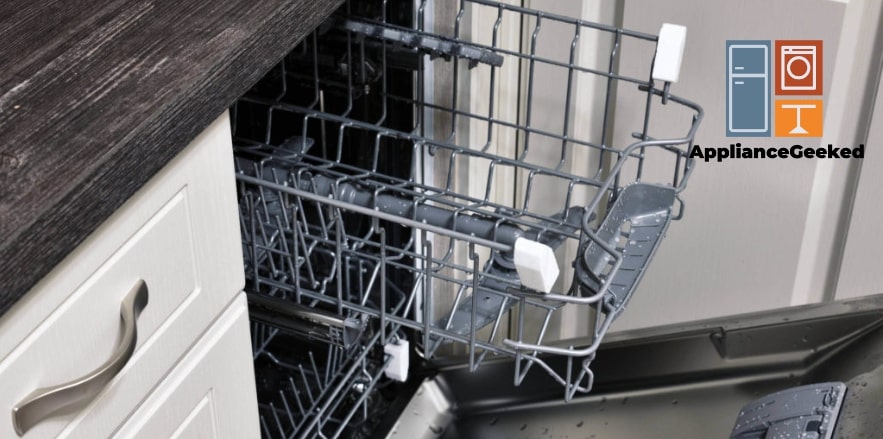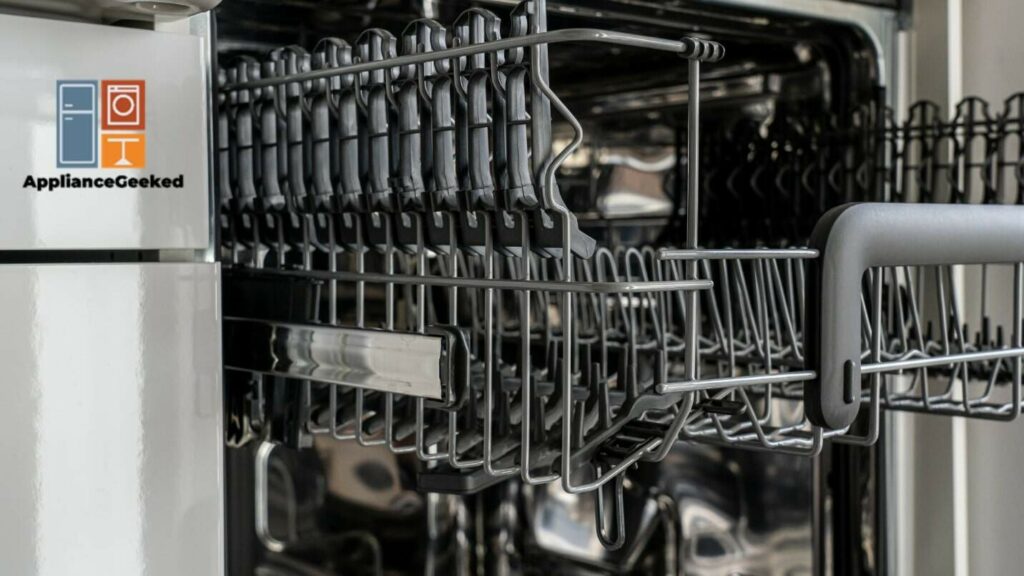The SC and SE error codes, more accurately read as 5C and 5E, are a few of the most common errors in both old and newly installed Samsung dishwashers.
In order to fix these errors, let’s dive immediately into what these codes indicate.
What does the SC/SE error code mean?
The SC/SE error code means that your dishwasher isn’t draining. This is usually caused by a clog in the drain hose or a faulty draining component.
Check for food waste or any debris that causes clogging. Also, make sure that the drain hose is straight, connected properly, and has no irregular bends.
If the error remains, try the following steps:
- Clean the filter, sump area, and drain valve from any dirt build-up.
- Make sure that your sink drain or garbage disposal isn’t filled with food waste that may restrict the water from flowing freely.
- Check for damages in the drain impeller, solenoid, and check valve.
If you need a more comprehensive guide on resolving the error, keep reading below.
Causes of an SC/SE Error Code and How to Fix it
The SC or SE draining error codes in your Samsung dishwasher are most commonly caused by a clogged component.
But to cover all the bases, we have listed all the possible reasons for the draining issue as well as solutions for resolving them. Let’s dive right in.
Here’s a quick overview.
| Cause | Solution |
| Malfunctioning Control Board | Reset the control board by powering off your dishwasher for 10 to 15 minutes then turning it back on. |
| Clogged Garbage Disposal or Sink Drain | Disconnect the drain hose and check if the garbage disposal cap has been removed. Clear the disposal or sink drain off any food residue and debris that is restricting the flow of wastewater. |
| Blocked or Bent Drain Hose | Detach the drain hose and test it for clogs in between. Clear the clogs and reinstall the hose. Also, make sure that the hose has no kinks or loose connections. |
| Uncleaned Drain Filter | Remove the filter assembly and clean all filters in running water using a soft brush. |
| Blockage in Sump Area | Remove any debris or dirt build-up in the sump area. You can use a straightened cloth hanger or handheld vacuum to do this. |
| Faulty Draining Components | Check the draining components for continuity or signs of damage. If they are faulty, have them replaced by a professional. |
Malfunctioning Control Board
Although it is uncommon for new dishwashers, we can’t rule out the possibility that the control board has become faulty.
This can be caused by mishandling during transport, installation, or use.
If the control board malfunctions, it may affect the sensors, causing them to display inaccurate errors on the panel.
A faulty control board would also fail to send out the right command to drain the dirty water inside your dishwasher.
Solution: Reset your dishwasher’s control panel to flush out any lagging commands and other systemic errors.
To do this, unplug your machine and wait for 10 to 15 minutes to clear your dishwasher from any electrical charge. Afterward, plug it back in and turn it on.
If there are no malfunctioning parts inside your dishwasher, rebooting it should resolve the SC or SE error codes.
Otherwise, keep on looking for clogs or damaged components in your dishwasher’s draining system.
Clogged Garbage Disposal or Sink Drain
Dishwashers are connected to the garbage disposal or sink drain to flush out the dirty water after each cycle.
However, if they are clogged due to frozen water or food waste coming from the sink, this could also block the water coming from your dishwasher.
It is also possible that you have forgotten to remove the garbage disposal cap when you installed the drain hose.
If this happens, the cap will prevent the water from entering the garbage disposal.
Solution: Make sure that your garbage disposal or sink drain is free from clogs.
Double-check that the cap is removed and taken out properly. If it’s not removed, detached your drain hose from the disposal and knock out the cap with a screwdriver.
Remove the cap from inside the garbage disposal and reattach the drain hose correctly and securely.
Blocked or Bent Drain Hose
One of the likeliest culprits for draining issues is the drain hose. If the hose has kinks or bends, this will restrict the flow of water from the dishwasher to the disposal.
Solution: Make sure that your dishwasher isn’t sitting on top of the drain hose. The weight of the machine itself is enough to pinch the hose and cause water blockage.
Also, check if there are any kinks or damages on the hose. Since the drain hose has a small diameter, a little bend would be enough to stop the water from draining properly.
If the hose is straightened and undamaged, make sure that it is connected to an air gap or has a high loop.
If your hose is installed without any of these, the dirty water may flow back into the dishwasher and prevent it from draining correctly.
Uncleaned Drain Filter
Cleaning your drain filters regularly will not only help avoid clogging but also prevent dirt build-up and smelly odors from your dishwasher.
Thankfully, most Samsung dishwasher models have an easily removable filter assembly to allow the owner to clean them.
Solution: Open the door and remove the lower rack. Hold the propeller, turn the assembly counterclockwise, and slowly pull it out.
Once you have removed the assembly, detach the coarse filter, fine filter, and main filter to clean them in running water.
However, be gentle when cleaning the filters and only use a soft brush to remove the dirt.
Poking the screens too hard may create wider gaps in the filter and cause food waste to pass through and be lodged in hard-to-reach areas.
Once you have cleaned the filters, make sure that you put them back correctly to avoid damaging or deforming them.
Blockage in Sump Area
If the drain filter is unable to sift all the dirt, its next stop would be the sump area. This area is what you see when you remove the filter assembly on top of it.
However, unlike the filter assembly, the sump area is not designed to be taken out easily.
Solution: To clean it, use a straightened cloth hanger to break off any gunks of dirt and pull them out.
You can also use a handheld dry and wet vacuum cleaner to make sure that you don’t miss any filth stuck in the sump.
Whenever you remove the filter assembly for a scheduled cleaning, make sure to take a pass at the sump area as well.
Faulty Draining Components
If you think that you have made your dishwasher squeaky clean but it still won’t drain properly, you may be looking at a damaged component.
Here’s where you can start checking:
Defective Sensor
The drain sensor, just like any other component, can be vulnerable to blockage and wearing out, causing it to display an error by mistake.
This phenomenon is called a false error. It occurs when the sensor has detected an error even when the hardware is working properly as it should.
Solution: If the problem is temporary, cleaning the sensor and rebooting your dishwasher should do the trick. But if that fails, it means that the sensor is damaged and needs to be replaced.
Damaged Impeller
When the washing cycle is done and it’s time to drain, it’s the impeller’s job to turn and force the dirty water out of your dishwasher.
If the drain impeller is damaged, it will be impossible for your dishwasher to drain properly, causing your tub to fill with water.
Solution: The impeller is a little difficult to inspect. Since it can only be accessed from the bottom of your dishwasher, you’ll need to be handy with tools in order to perform the inspection safely.
If you aren’t confident with tools, it would be best to ask the help of a professional.
If there is damage to the impeller, it will need to be replaced.
Damaged Motor
The motor pump powers the impeller during the drain cycle. But if the motor pump is damaged, the impeller won’t be able to turn and drain the water out.
Similarly, checking the motor pump requires a certain amount of technical know-how. However, there are some telltale signs that’ll tell you that the motor pump is damaged.
The first is a low-humming noise indicating that the motor pump is no longer able to spin the impeller. Another sign is a loud squeal, which means that the pump’s bearing is already damaged.
Solution: Drain pumps aren’t designed to be repaired. Once it’s damaged, you need to ask for an expert appliance repair man to remove the old pump and reinstall a new one.
Faulty Solenoid
As mentioned above, it’s the drain motor pump and the impeller’s job to push the dirty water out of the machine.
However, the water would still need to go through the exit valve in order to enter the drain hose. And this valve is opened by the solenoid.
During the drain cycle, an electric signal triggers the solenoid to open the exit valve. But if the solenoid becomes faulty, the valve will remain closed, preventing the water from getting out.
Solution: If you are handy with tools, you can use an ohmmeter to check for continuity in the solenoid.
First, make sure that the dishwasher is disconnected from the power and water supply. Then, touch the terminals with the probes and check if the reading changes from infinity to 40 ohms.
If the reading does not change or is nowhere near 40 ohms, the solenoid is already damaged and needs to be replaced.
On the other hand, if you are not very experienced with the tool, call an expert to help you diagnose and if necessary, replace the damaged solenoid as well.
Stuck Flapper
The flapper, also known as the check valve, only lets the dirty water flow in one direction once it’s been drained — out of the machine and into the drain hose.
However, if the flapper is clogged or blocked by debris, it may remain stuck in a closed position.
This means that the dirty water would be stopped dead in its tracks before it reaches the drain hose.
A damaged check valve may also allow the wastewater to re-enter the dishwasher, especially when the motor pump is working slower than normal.
Solution: Make sure that the flapper is still in good condition, checking and removing clogs that prevent it from moving freely.
If the check valve is damaged, refer to your manual for its specifications and replace it with a new one.
Resolving the SC and SE error code should be simpler by following the instructions above.
Still, calling for professional help is always a good choice. Contact the Samsung Support Center or go to your local appliance repair shop if you need more assistance.




